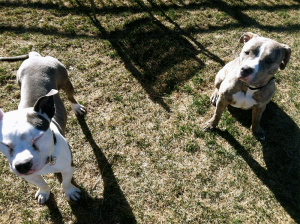People often ask me questions such as, “My dog is really vocal when she plays, is that bad?” My response is often, “Maybe, it depends on the dog! It could be problematic, or it may just be her play style.” Or a client will comment, “My dog loves going to the dog park.” Upon further questioning, I discover that their dog actively avoids all other dogs while there, spending the majority of his time sniffing the perimeter of the park. This behavior leads me to believe their dog is either indifferent toward other dogs (which is perfectly fine) or possibly, quite stressed and simply trying to cope.
In this post, I hope to highlight what to watch for that indicates that healthy play is occurring (it’s so much more than just a wagging tail), so that you can better identify when intervention (or training support) is needed; or when to sit back, relax and revel in the joy of watching well-matched dogs play.
The first sign of healthy play is something called role-reversal. Role reversal means that there is a give and take, a back and forth, present in play. In other words, I chase you and then you chase me; I pounce on you and you pounce on me; I chew on your neck and then you chew on mine. This hardly ever happens in an even 50/50 split, but this shift should be taking place throughout the course of play. As you will see with all the components of healthy play, the better two dogs know one another, the more we see these formalities loosen. I’ll talk more about this below.
The second sign of healthy play is the presence of shifts in activity. We want to see dogs running, then tumbling, then possibly taking a break or grabbing a sip of water. After the water, maybe they run again, followed by a shift to wrestling. These shifts prevent escalation in a solitary portion of the play.
Third, we are watching for something called meta-signals. Meta signals are contextual clues that tell one dog that the behavior following the meta-signal is just play. Because the behavior present in play is often a rehearsal of behavior present in other aspects of life (aggression, predation, reproduction), a dog needs a way to say, “Yes, I am going to slam you against a wall, but it is just play, I am not trying to hurt you.” Meta-signals include behaviors such as paw raises, lip licks and play bows (where the dog places their front elbows on the ground, while their rear remains in the air). The meta-signal would proceed the “questionable” behavior.
Lastly, healthy play should include self-handicapping. Self-handicapping is one of the more magical pieces of healthy play, especially when a dog is skilled in this arena. Self-handicapping means that a more powerful, capable, larger or older dog would inhibit themselves to meet the needs of less powerful, smaller, less capable or younger dog. You might see the larger dog roll onto their back or crawl on their belly to match the size of the smaller dog. You might see a powerful adult, gently mouth the neck of a fragile puppy or gallop slowly toward an older dog who is not as fast as they once were.
In closing, the better friends that two dogs are, and the more time they spend playing together, the less obvious, formal and more abbreviated these will be. Think of it like the difference in how you might act when meeting a potential employer verses greeting your spouse.
I hope this article helped you to better understand what to look for to tell you if your dog is enjoying play. Now go out and have some fun with your dog(s)!

